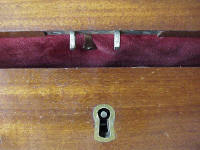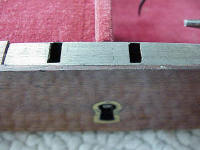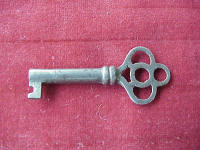It is not unusual to have
difficulty unlocking a 100 year old surgical set case. The trick is
lubrication and knowing how they work.


Lid prongs (On left, prongs upside down. On right, prongs descending
into latch)


Lock in frame (On left, holes which prongs enter. On right the
typical skeleton key
Typically there is a set
(or a single) of vertical prongs on the lid that engage the lock in the case frame. If the
box is locked and you have the key, here is how you open and close as case:
To lock:
1. Insert the key, with the 'skeleton leg'
down.
2.Turn clockwise until a firm resistance is
felt; the case is then locked.
3. To remove the key, turn counterclockwise
so the filigree key end is at the nearest vertical position, then pull it out.
To unlock:
1. Insert the key with the skeleton leg down.
2. Turn the key counterclockwise until a firm
resistance is felt, the case is then locked.
3. To remove the key, turn clockwise, so the
filigree key end is at the nearest vertical position, and pull it out.
Is you suspect the locking
mechanism is sticky, first try powdered graphite, which you can get in a tube
from a hardware store. If that fails, then use WD-40, and spray a very,
very light amount of WD-40 to the key hole and turn the case upside down to
allow some of the oil to drain into the lock parts in the lid. Always use
the minimum amount of oil necessary to do the job. You don't want to ruin
the velvet liner in the case, but you don't want to break the lock or wood
either.
Under no circumstances
should you attempt to pry open the case. If in doubt, take the case to a
locksmith and ask them to open it for you, which they WILL be able to do without
harming the wood. Otherwise you may seriously
decrease the value of the set and you absolutely cannot fix it if you do.
Military latches are
pretty easy. Again try moving the sliding latch from side to side first,
if it's too hard to move, don't force it. Add a tiny spray of WD-40 first,
then with your fingers, try to slide the latches from side to side.
They vary in which direction is open and which is locked. If still unable,
use a wood stick or piece of wood dowel and tap the sliding latch to the
opposite side. CAREFULLY!
|
Military sliding latches, two
types from different makers |

 |
Also, see
surgery case locks for variations on
locks